Energy for Transportation
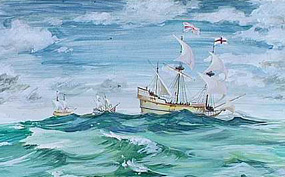
Susan Constant, Godspeed, and Discovery brought 104 colonists to Jamestown in 1607
Source: National Park Service, What Happened to the Three Ships?
The Native Americans paddled or walked. If the Europeans had arrived centuries later, the Native Americans in Virginia might have improved their agricultural technology and produced a surplus of food - an essential step in the development of urban centers.
In such centers, people with specialized skills (other than farming) may have invented additional technologies, including wheeled vehicles and sailing ships. However, when Jamestown was settled, the various tribes in Virginia relied solely upon human-power transportation.
The colonists relied heavily upon human-power transportation, but also utilized a renewable energy resource - wind. Trans-Atlantic trips were a basic part of Virginia's colonial economy, and wind was the major source of energy for long-distance journeys. Only after the Civil War did steamships replace sailing vessels for routine trans-Atlantic journeys.
- What is the major source of energy for long-distance shipping now? Petroleum, "bunker fuel" refined for ship engines. Until the 1950's, ships entering the Chesapeake Bay at the end of a cross-Atlantic trip would flush their fuel storage tanks and dump the "ballast water" with oily fuel residue into the water.
- Today, such pollution is prohibited - but fuel oil remains a major pollution threat in Tidewater when there is a shipwreck. West of the Fall Line, such pollution is more likely from rainwater that washes across roads and parking lots where cars have leaked petroleum or from truck accidents. Keeping the waters of Virginia clean requires firemen to spread sawdust and clay (kitty litter...) on diesel spills at truck wrecks and then collect the soaked material - we can no longer wash the spilled fuel into the creeks.
The early settlers also built windmills at Norfolk to provide mechanical energy for grinding the wheat that was grown south of Hampton Roads. That wheat was baked into biscuits and sold as food for sailors. There's a curious circle here - wind energy enabled the bakers to provide food energy to sailors, who used wind energy to carry tobacco to Europe... where smokers had their lung capacity reduced.
Today, the wind energy potential for Virginia varies across the state. The coastline has higher potential, because the land and water will cool/heat at different rates. Wind is generated by warmer air rising and moving in relation to cooler air, and the temperature differentials between land and water on the coastline create the pattern of "potential 3" along the Chesapeake Bay, "potential 2" slightly inland, and "potential 1" in the Coastal Plain and Piedmont. The elevation differences in western Virginia provide higher potential in some areas.
Note the elliptical zone with "potential 1" west of the 81st degree of longitude. That shows Burke's Garden on the edge of Tazewell and Bland counties, a valley surrounded by high ridges:

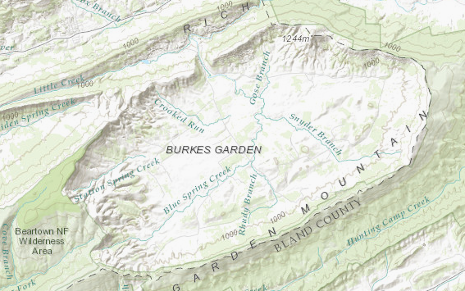
wind energy potential in Virginia is higher on ridges, and low at the bottom of Burke's Garden
Sources: Wind Energy Resource Atlas of the United States; ESRI, ArcGIS Online
The Europeans brought horses, mules, and oxen (as well as human laborers) to plant and harvest tobacco, corn, and wheat. Even with metal tools, the Europeans also found farming to be exhausting work. In addition to planting and harvesting crops, farmers had to build fences to keep animals out of the farm fields - and they had to create a road network to transport their crops to market.
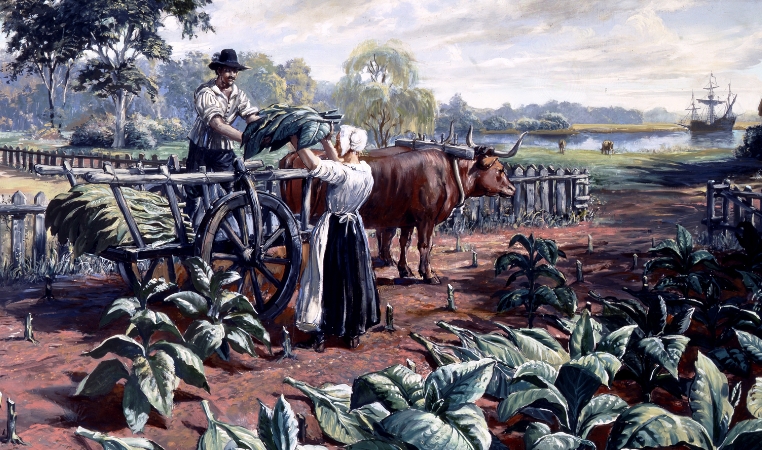
tobacco production at Jamestown (note the short distance required to carry the tobacco on an ox cart along a dirt road to the ship in the distance)
Source: National Park Service - Sidney King collection of paintings created for the 350th Anniversary of Jamestown
There was no Virginia Department of Transportation (VDOT) in the colonial days. Instead, every landowner was obligated to provide some labor to work on the roads next to their property, to keep them in passable condition.
Maintaining dirt roads with just hand tools (picks, shovels, rakes...) was not easy, but the roads were essential for getting agricultural crops from farm to market. The county court enforced the requirement, and the colonial records of the county courts in Virginia are filled with orders requiring landowners to perform road work so hogsheads and wagonloads of crops could be transported by horses, oxen, and miles to the wharves and loaded into sailing ships.
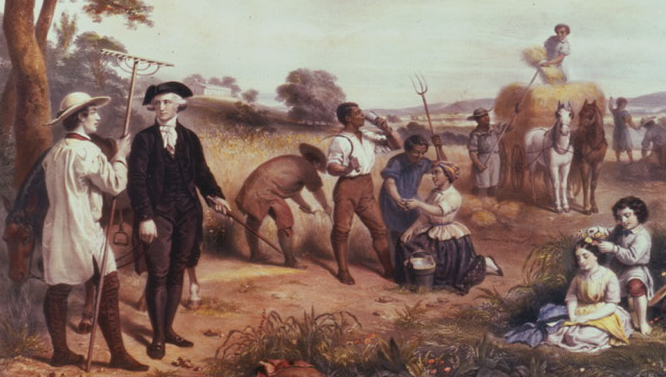
farming relied upon animal power and human power - which was provided by slaves in much of Virginia
Source: Library of Congress, Life of George Washington--The farmer
Justices of the Peace formed the local "court" in each county. There was no separation of powers in colonial Virginia's government. The justices were responsible for executive tasks such as road maintenance, as well as judicial and legislative tasks.
The Justices were appointed by the royal governor, but practically the local members in the House of Burgesses had major influence in who was appointed. No local officials were elected in colonial Virginia - voters could only select the two members sent from each county to the House of Burgesses.
Landowners who were unhappy with decisions of the local county court had no opportunity to "vote the local bums out" until Virginia declared independence and shifted from being a colony to an independent state in 1776.
Through colonial times and even beyond the Civil War, transportation in Virginia was fueled by human muscles, wind, and horses/mules/oxen - until wood, coal and ultimately oil were used to power internal combustion engines.
River currents also carried cargo and passengers on boats, though currents flowed in only one direction. Port Republic on the South Fork of the Shenandoah River was the starting point for boats that floated downstream to Harpers Ferry, where the cargoes were sold and the boats were disassembled to become lumber for local house construction. Canals lacked a current; canal boats on the James River and Kanawha Canal and other canals in Virginia relied upon mules to pull the boats.
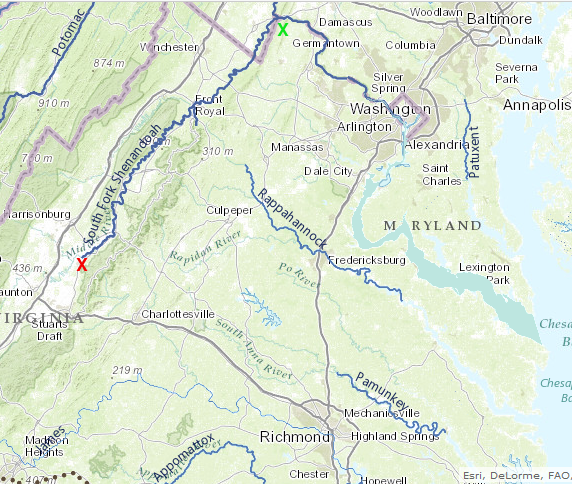
floating downstream from Port Republic (red X) to Harpers Ferry (green X) was easier than hauling farm products over the Blue Ridge to the market in Charlottesville or Richmond
Source: ESRI, ArcGIS Online
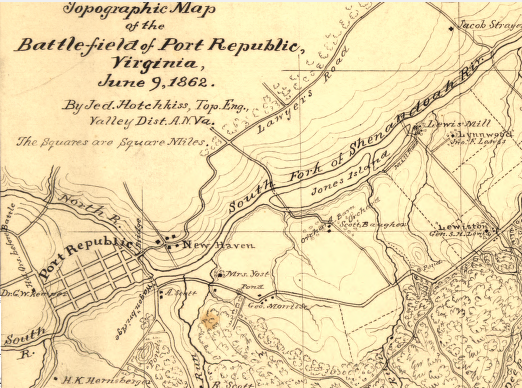
Port Republic was also the site of a battle in the Civil War
Source: Library of Congress, Topographic map of the battle-field of Port Republic, Virginia, June 9, 1862
The boatmen used small open fires for cooking their meals. In 1983, the Great Basin in downtown Richmond (where canal boats unloaded and turned around) was excavated during construction of the James River Center. The Virginia Canals and Navigation Society was able to examine some of the sunken boats buried in the sediments at the bottom of the basin, in a salvage archeology effort that was just a half-step ahead of the excavation equipment. Recovered boats showed clearly that embers had escaped the cooking hearth and charred the wood planks of some canal boats - despite the brick/sandstone interiors of the hearth, and edges of pig iron used as insulation between the fire and the planks.1
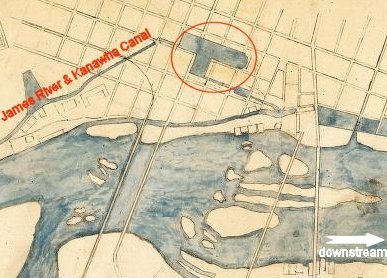
Boat Basin (circled) in Richmond, about 1850
Source: The Library of Virginia, A map of Richmond's water front from the Penitentiary on Spring St. to Rockett's
After the Civil War, locomotives and ships were converted to coal. In the early 1900's, the automobile industry finally settled upon gasoline as the primary fuel source. A massive road construction program in the 1900's transformed the Virginia landscape in less than a century, and gas stations became common while blacksmiths and their forges almost completely disappeared. (Use the Geographic Names Information Server to see how many places in Virginia include "forge" in their name.)
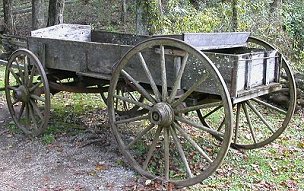
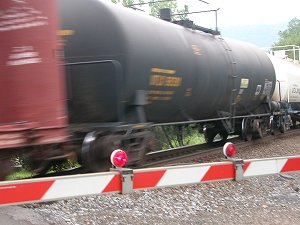
the generic cart has evolved into specialized forms of transportation, including railroad tanker cars
Richmond was the first American city to power street cars by electricity in the 1880's. The coal-powered steam locomotives lasted into the 1950's, with the Norfolk and Western being the last Class 1 railroad to shift to diesel.
Electricity was used to power locomotives in a few cases in the first half of the 1900's. Overhead power lines were installed to carry electricity from generating stations to the locomotives, including on the Pennsylvania Railroad line from Washington DC into Potomac Yard at Alexandria and on the Virginian Railroad line from Glen Lyn to Roanoke. In both examples, coal-fired locomotives created too much smoke for the engineers to go safely through tunnels. Electrification was an effective way to keep trains moving, without suffocating crews in locomotives and cabooses.
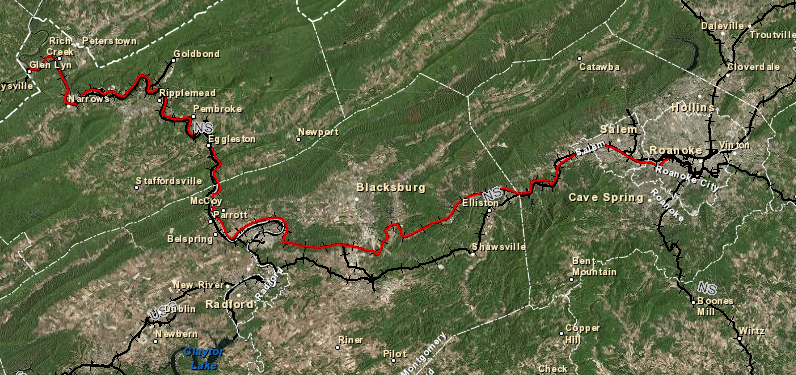
locomotives on the Virginian Railroad used electricity between Glen Lyn-Roanoke, minimizing smoke in the Allegheny Tunnel (underneath modern US 460 in Montgomery County)
Source: ESRI, ArcGIS Online
The Metrorail cars in Northern Virginia are powered by electricity transmitted via the third rail on the trackbed. Modern CSX and Norfolk Southern freight locomotives, and Amtrak/Virginia Railway Express passenger rail locomotives, use diesel fuel. The old tender car with firewood or coal has been eliminated, and the diesel is carried in tanks on each locomotive.
On board those locomotives, diesel fuel is burned to power electrical generators and the electricity is used by electrical engines that turn the locomotive wheels. Locomotives are often described as diesel-electric engines, and are mobile power plants - just like modern ocean-going ships (except for aircraft carriers and submarines that use nuclear power). Shipping cargo by trains is 2-5 times more fuel-efficient than trucks, for inland transportation.2
Diesel fuel, gasoline, and jet fuel for airplanes is refined primarily in Texas/Louisiana, then transported into Virginia by pipeline and ship. Most of the tanker cars behind a locomotive are carrying chemicals to industrial facilities; trains are less efficient than pipelines for shipping gasoline/diesel for fuel.
Petroleum is the #1 transportation fuel for modern Virginia. Electricity for transportation is limited to a few hybrid cars, though the potential for battery-powered cars charged by solar cells is clearly rising.
Natural gas fuels transit fleets in a few urban areas, because the engines (especially on buses) emit less air pollution. President Bush called for a shift to hydrogen-powered vehicles in his 2006 State of the Union address, but the challenge of converting even a small percentage of over 4,000 or so gas stations in Virginia to a different fuel helped sink that vision.
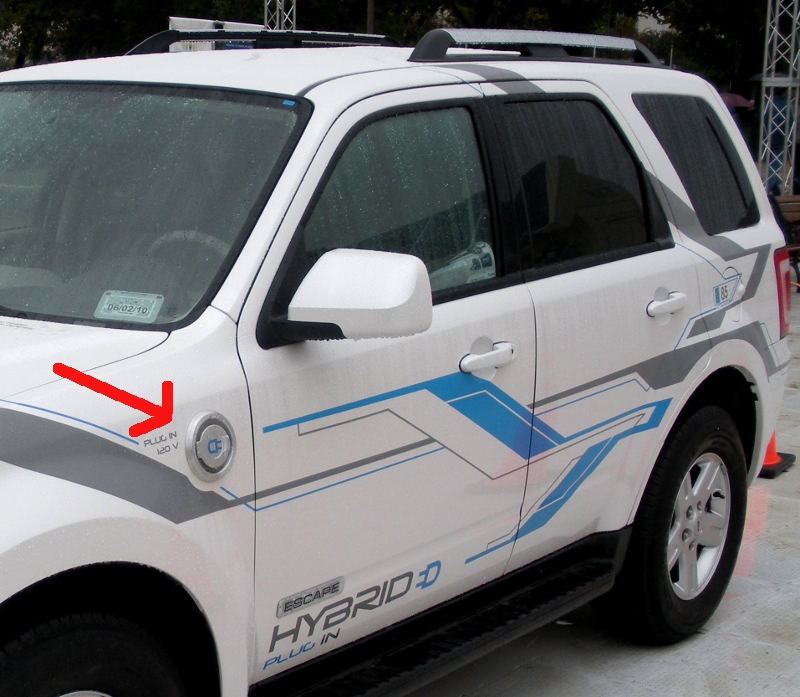
it is far easier to build recharging stations for electric plug-in cars than to create a new network of hydrogen-based fueling stations, suggesting which alternative to gasoline is likely to be adopted commercially
The most exotic fuel used in Virginia for transportation is nuclear energy, used for military vessels. The US military has nuclear-powered submarines and aircraft carriers based in Hampton Roads, and the shipbuilding and ship repair workforce there has experience in working with reactors.
Lynchburg is the US headquarters for a European company (AREVA NP) that expected to build the EPR (Evolutionary Pressurized Reactor) for generating electricity. In 2008, the company announced plans to add over 500 jobs in Lynchburg and to partner with Northrop Grumman Shipbuilding to manufacture parts for nuclear power plants in Newport News. A competitor also located in Lynchburg, Babcock and Wilcox, also expected to win contracts to build new nuclear reactors using a different design.
Those plans were put on hold after the recession started that year. While Lynchburg remains the center of engineering for nuclear power plants, there are few customers willing to invest in nuclear - and the Coles Hill uranium deposit in Pittsylvania County, with a value estimated at times as high as $10 billion, still remains undeveloped.3
References
1. "Richmond Canal Basin Dig: The Men, The Boats, The Mud" in The Tiller, Virginia Canals and Navigation Society, pp.10-15
2. "Final Report: Comparative Evaluation of Rail and Truck Fuel Efficiency on Competitive Corridors," Federal Railroad Administration, November 19, 2009, http://www.fra.dot.gov/Downloads/Comparative_Evaluation_Rail_Truck_Fuel_Efficiency.pdf (last checked November 8, 2012)
3. "Areva plant expansion on hold," Lynchburg News and Advance, May 16, 2009, http://www2.newsadvance.com/lna/news/local/article/areva_plant_expansion_on_hold/16007/; "Joint venture will build nuclear reactors in Newport News," The Virginian-Pilot, October 24, 2008, http://hamptonroads.com/2008/10/joint-venture-will-build-nuclear-reactors-newport-news (last checked November 4, 2009)
Virginia Places











